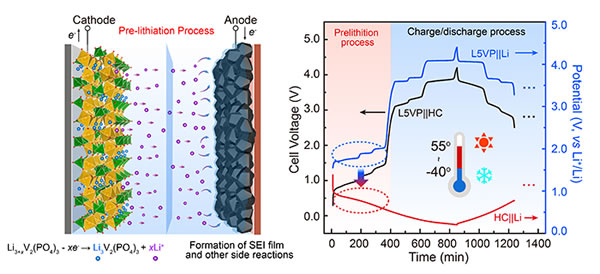Recently, the team of Zhang Huamin, Li Xianfeng, and Zhang Hongzhang, researchers of the Energy Storage Technology Research Department of the Dalian Institute of Chemical Physics, Chinese Academy of Sciences, and the team of Wang Qingsong, a professor of the State Key Laboratory of Fire Science, University of Science and Technology of China, proposed a method of using lithium lithium vanadium phosphate (PO4) 3) Achieve "prior to take" additive-free self-pre-lithiation strategy, and use lithium lithium vanadium phosphate and hard carbon (HC) to form a high specific energy, high specific power and wide operating temperature range Full battery. Improving low-temperature performance is one of the keys to achieving wider application of lithium-ion batteries. However, the actual capacity of graphite anodes currently used in commercial lithium-ion batteries is low under low-temperature conditions. Hard carbon has good low-temperature lithium storage capacity, which can effectively improve the low-temperature performance of the battery. However, during battery formation, the solid electrode / electrolyte interface (SEI) film formed at the interface of the hard carbon anode will irreversibly consume Li +, thereby reducing the actual capacity and specific energy of the battery. Pre-lithiation is a common strategy to solve the above problems, but the method of directly using lithium powder or lithium foil to supplement lithium in actual production requires strict technology, high cost and poor safety. Therefore, efficient and safe pre-lithiation technology still needs to be studied. In this work, the scientific research personnel chose lithium lithium vanadium phosphate with good low temperature performance and hard carbon anode to form a full battery, and skillfully used the capacity of lithium lithium vanadium phosphate in the low voltage region to compensate the irreversible capacity loss of hard carbon anode, which effectively improved The specific energy of the battery. The specific energy of the obtained full battery based on the positive and negative electrode active materials can reach 320 Wh / kg at room temperature, and it still has an 80% capacity retention rate during charge and discharge at a low temperature of -40 ° C. In-situ characterization and thermal analysis results show that the lithium vanadium phosphate has a stable structure during charge and discharge, low heat generation, and good safety. This pre-lithiation method provides a new strategy to make up for the first irreversible capacity loss of the negative electrode. At the same time, the design of Li5V2 (PO4) 3 || HC battery provides a potential application option for low-temperature lithium-ion batteries. The above work was supported by the cooperative project of the Clean Energy Innovation Institute of the Chinese Academy of Sciences, the National Natural Science Foundation of China, the Collaborative Innovation Center for Energy Materials Chemistry (iChEM) of the Ministry of Education, and the Youth Promotion Association of the Chinese Academy of Sciences. Related research results were published in "Nano Energy" (Nano Energy) recently. Custom Valve Covers,Valve Element Brass Fitting,Forging Brass Faucet Body,Brass Fitting For The Valve Element JIANGMEN YILIN PRECISION MANUFACTURING CO.,LTD , https://www.ylseiko.com
Looking for a custom Valve Element manufacturer in China? Need Valve Fitting designing and manufacturing in China? Custom Brass Faucet Fitting production services needed? No problem, contact us now and find out how we can help you. We accept small orders and can handle high-volume orders up to millions of parts.